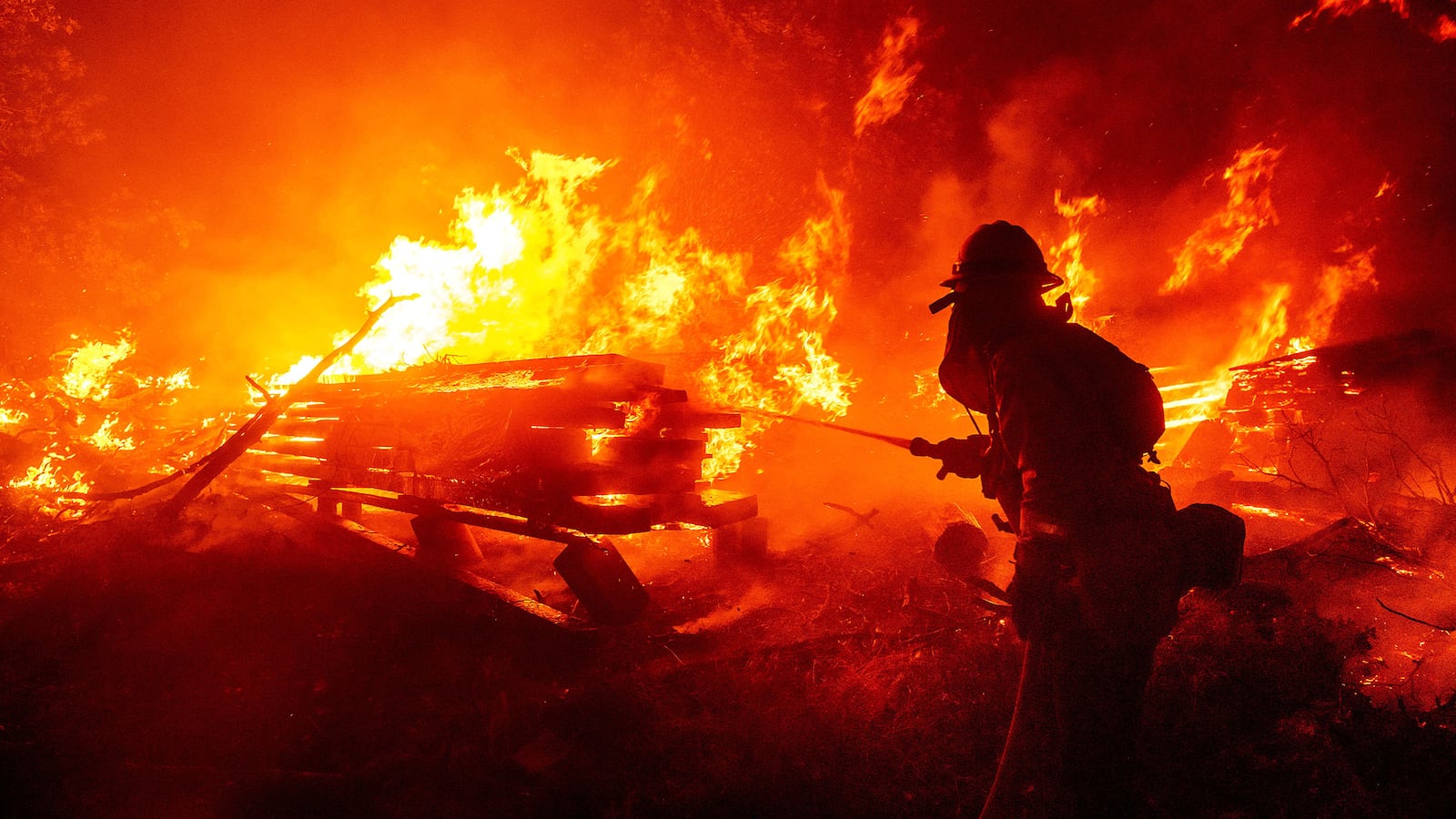It wasn’t all that long ago that banking on a relentless array of cascading wildfires consuming generous swaths of the United States was, well, a bit alarmist.
In 2006—the year Al Gore’s documentary An Inconvenient Truth debuted—widely respected climate journalist Elizabeth Kolbert wrote in her book Field Notes From a Catastrophe, “In the Southwest, forest fires are breaking out earlier, and burning more intensely.” Still, she noted in that same book that the frequency of fires was among “the uncertainties that remain,” among scientists exploring the effects of climate change.
In science, consensus comes slowly, but it seems to have arrived in this case—and it’s not pleasant. From routine fire tornadoes to generations of kids being radically altered by inhaling the smoke borne from wildfires hitting urban areas (and not just forests), scientists are painting a dire picture of the future, one made even spookier by a dearth of unknowns.
“The underlying denominator tends to be the fuels, and it’s hard to picture, given a warming climate, how that situation is going to improve in the near term,” said Neil Lareau, a physicist who researches smoke plumes at the University of Nevada, Reno.
Worse still: “Generally speaking, we should expect worsening fire seasons in the future,” Adam Kochanski, an atmospheric scientist focused on fires at the Wildfire Interdisciplinary Research Center at San Jose State University, told The Daily Beast.
“We have to keep in mind that the current season is exceptional,” Kochanski added. Five million acres have burned since August. Six of the 20 largest individual fires in California history occurred this year. The Bay Area is blanketed in an unprecedented layer of smoke, turning the skies a hellish vermilion, and dozens are dead in connection with fires not just in that state, but also in Oregon and Washington.
But while we are finally getting something resembling certainty from the experts about a coming increase in wildfires—above and beyond the already nightmarish present—scientists don’t know exactly what these future nightmares will bring. Fire and smoke, to be sure, but what side effects we’ll see as a result of those obvious new realities is still the domain of speculation and modeling.
Among the under-researched problems on the horizon include untold health effects that have never been studied before.
“While we have consistent evidence that air pollution from wildfire smoke is associated with spikes in use of asthma medication and emergency room visits for things like trouble breathing or cardiovascular issues, we don’t really know what the long-term effects are of repeated exposure to smoke every wildfire season,“ said Micah Hahn, assistant professor of environmental health at the University of Alaska, Anchorage.
According to Hahn, we urgently need to know about “the potential exposures from urban wildfires that are burning man-made materials in comparison to wildfires that consume forests.”
At the moment, Hahn explained, researchers have “a bit of research on exposures from the fires at the World Trade Center [after the 9/11 attacks]” and little else to learn from.
“There are of course the physical impacts of breathing smoke year after year, but we also do not know about the potential mental health impacts of evacuation, displacement, losing your home and property, or just living with the anxiety of future wildfires,” she said.
All of this is ripe for long-term health research that has yet to proceed. And scientists’ plea is that they’ll receive the resources they need to learn how we might mitigate all this future horror.
“The money available for studying the effects of fire in a research setting has gone down,” said Erica Fleishman, land use researcher, and director of the Oregon Climate Change Research Institute. “There are a lot of questions that are increasingly difficult to study outside of the context of an immediate fire situation.”
As for the physics of the fires themselves, we’re in for a number of rude awakenings, and we only have hints as to what the firefighters of the future will be up against. For instance, according to Lareau, the smoke plume researcher, scientists urgently need to figure out “when the fire-induced winds—meaning the winds generated by the fire—become the primary driver of the fire itself, giving it a life of its own.”
Perhaps an even scarier question from Lareau is the one about terrifying fire-generated tornadoes like the one photographed in California that has since circulated widely on the internet. “Under what conditions—basically when, where, and why—do we develop fire generated tornadoes that are potentially deadly?” Lareau said.
Fire-generated tornadoes are, according to Lareau, “still rare events.” But we need to know the probabilities as fires increase, because as fires become more ubiquitous, they may begin to seem common—turning into phenomena that average people in the western United States must grow accustomed to.
In some set of circumstances, he said, “if it’s a one-in-a-hundred event and you have 7,000 fires burning in the Western United States, you’re going to see these things,” he told The Daily Beast.
President Trump has stayed mostly on-message about what he thinks is causing these fires: too much flammable material out in the wilderness. “You gotta clean your floors. You gotta clean your forests. There are many, many years of leaves and broken trees and they’re like, like, so flammable, you touch them and it goes up,” Trump told a Pennsylvania rally crowd in August. He repeated this theory to state authorities in California on Monday, including a bizarre remark about exploding trees.
Like so many of Trump’s hot takes on science, this one brushes up against hypotheses from real scientists, but it’s also miles from being in line with any sort of consensus drawn from evidence. Part of the problem, Fleishman said, is that research simply hasn’t been carried out to prove or disprove it.
The leaf-blower-toting armies Trump evokes are pure fantasy, but controlled burns are a potential option—though not in wooded areas like California’s ancient redwood forests. It might, however, be worth it to “clean” away some of California’s chaparral with the careful use of intentional fires in areas like the Mojave Desert or the Sierra Nevada foothills, where indigenous people once controlled wildfires with just such a strategy: controlled burns, also known as “prescribed fire.”
“So much of Southern California, where people live, is in chaparral, and chaparral is fire-dependent,” Fleishman said.
So should Californians get used to the sight of controlled burns of desert brush, perhaps in the cooler seasons, or at times when there’s no wind? Only if someone deigns to figure out how such a thing would work. “It’s been fairly difficult to conduct comprehensive research on prescribed fire,” Fleishman said, noting that, “There are concerns about fires escaping.”
Lareau agreed that scientists urgently need to know more about controlled fires. “The big question is do you want the fire now, or do you want it later? And do you want to be in charge of how that fire is going to burn, or do you want it to be left to its own devices?”
One option for learning how to control fires like this is computer models, Fleishman said. But sadly, she pointed out, “There are any number of excellent models, but it’s a challenge when you build models and you don’t have as much ground data as you would like, to see if your modeling assumptions are accurate.” It’s not entirely unlike the uncertainty plaguing public health officials who rely on computer models of COVID-19 spread in order to try and contain the pandemic.
Perhaps most tragically of all, we don’t know, from year to year, how these fires affect the West Coast’s plants and animals—humans among them. But these changes in the ecosystem aren’t just heartstrings-tugging factoids. We urgently need to know what the trends are with the local flora, because different species burn differently.
And some living things cope better than others.
As Lareau put it, “We’re in a warming world, and it may be favoring slightly different species to be repopulating these different environments after they burn as severely as they do.”







